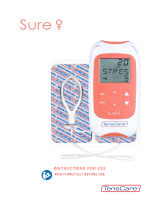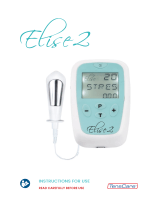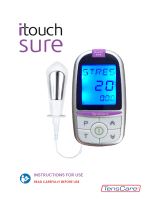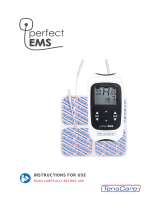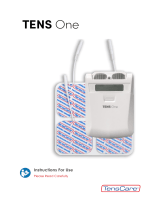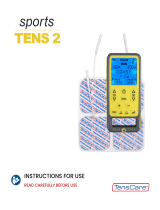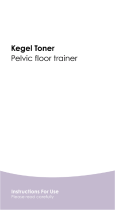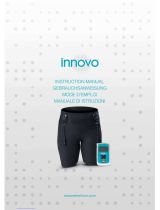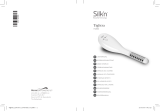La page est en cours de chargement...

0

1
UK Clean the probe with an alcohol-free
anti-bacterial wipe or with warm soapy
water.
ES Limpie la sonda con una toallita
antibacteriana sin alcohol o con agua
jabonosa tibia.
FR Nettoyez la sonde avec une lingette
antibactérienne sans alcool ou de l'eau
savonneuse tiède.
DE Reinigen Sie die Sonde mit einem
alkoholfreien antibakteriellen Tuch oder
lauwarmem Seifenwasser.
UK Connect the lead wires to the electrode
pads or vaginal probe and then insert the
white pin into the device.
ES Conecte los cables conductores a los
electrodos o la sonda y luego inserte el pin
blanco en el dispositivo.
FR Connectez les fils conducteurs aux
électrodes ou la sonde, puis insérez la
broche blanche dans l'appareil.
DE Schließen Sie die Anschlussdrähte an die
Elektrodenpads oder der Vaginal-sonde
an und stecken Sie den weißen Stift in das
Gerät.
UK Place electrode or insert the vaginal
probe (apply lubricant or water
beforehand).
ES Coloque el electrodo o inserte la sonda
vaginal (aplique lubricante o agua de
antemano).
FR Placer l'électrode ou insérer la sonde
vaginale (appliquer au préalable du
lubrifiant ou de l'eau).
DE Platzieren Sie die Elektrode oder führen
Sie die Vaginalsonde eiN (tragen Sie vorher
Gleitmittel oder Wasser auf).

2
UK Press and hold the power button for 3-5
seconds to switch the device on.
ES Mantenga presionado el botón de
encendido durante 3-5 segundos para
encender el dispositivo.
FR Appuyez sur le bouton d'alimentation et
maintenez-le enfoncé pendant 3 à 5
secondes pour allumer l'appareil.
DE Halten Sie den Netzschalter 3 bis 5
Sekunden lang gedrückt, um das Gerät
einzuschalten.
UK Select the programme by pressing the
settings button.
ES Seleccione el programa presionando el
botón de configuración.
FR Sélectionnez le programme en
appuyant sur le bouton des paramètres.
DE Wählen Sie das Programm durch
Drücken der Einstellungstaste aus.
UK Adjust the intensity with the up and
down buttons.
ES Ajuste la intensidad con los botones
arriba y abajo.
FR Réglez l'intensité avec les boutons haut
et bas.
DE Stellen Sie die Intensität mit den Auf-
und Ab-Tasten ein.

3
Dear Customer,
Thank you for choosing Unicare. TensCare stands for high-quality, thoroughly
tested products for the applications in the areas of gentle electrotherapy,
muscle toning, continence management and pain relief during labour.
Please read these instructions for use carefully and keep them for later use, be
sure to make them accessible to other users and observe the information they
contain.
Best regards,
Your TensCare Team

4
CONTENTS
1. INTRODUCTION ............................................................................................................. 7
2. INTENDED USE ............................................................................................................... 8
3. UNICARE FEATURES ....................................................................................................... 8
4. PELVIC FLOOR EXERCISES ............................................................................................ 9
4.1. PELVIC FLOOR MUSCLES ....................................................................................... 9
4.2. PERFORMING PELVIC FLOOR EXERCISES.............................................................10
5. TYPES OF INCONTINENCE ............................................................................................11
6. PERIOD PAIN ................................................................................................................12
7. HOW ‘EMS’ WORKS .....................................................................................................13
8. HOW ‘TENS’ WORKS ....................................................................................................14
9. CONTRAINDICATIONS, WARNINGS & CAUTIONS ......................................................15
10. INFORMATION ABOUT THE PROGRAMME SETTINGS ..................................................20
11. PROGRAMMES.............................................................................................................21
11.1. PROGRAMME SETTINGS ....................................................................................21
11.2. PRESET PROGRAMMES ......................................................................................21
12. CONTENT ......................................................................................................................22
13. UNIT INFORMATION .....................................................................................................23
13.1. CONTROLS & DISPLAY ......................................................................................23
13.2. OPERATING INSTRUCTIONS ...............................................................................24
14. SETTING UP AND USING THE UNICARE ........................................................................26
14.1. CHARGING THE BATTERY ..................................................................................26
14.2. CONNECTING LEAD WIRE ................................................................................28
14.3. PREPARING FOR SESSION .................................................................................28
14.4. TRAINING SESSION ............................................................................................29
14.5. AFTER YOUR TRAINING SESSION .......................................................................32
15. PAIN PROGRAMME .....................................................................................................32
16. CLEANING ....................................................................................................................33
17. EMC ..............................................................................................................................33
18. DISPOSAL OF WASTE ELECTRICAL AND ELECTRONIC PRODUCTS (WEEE) ................34
19. ACCESSORIES ..............................................................................................................34
20. WARRANTY ...................................................................................................................35
21. TROUBLESHOOTING .....................................................................................................36
22. GENERAL SPECIFICATION ............................................................................................39

5
SYMBOLS USED
TYPE BF APPLIED PART: Equipment providing a degree of protection
against electric shock, with isolated applied part. Indicates that this
device has conductive contact with the end user.
This symbol on the unit means “Refer to instructions for use”.
Temperature Limitation: indicates the temperature limits to which the
medical device can be safely exposed.
Lot Number: indicates the manufacturer’s batch code so that the batch
or lot can be identified.
Humidity Limitation: indicates the humidity limits to which the medical
device can be safely exposed.
Serial Number: indicates the manufacturer’s serial number so that a
specific medical device can be identified.
Do not dispose in household waste.
Catalogue Number: indicates the manufacturer’s catalogue number so
that the device can be identified.
Atmospheric Pressure: indicates the atmospheric limits to which the
medical device can be safely exposed.
Manufacturer Symbol
Date of Manufacture: indicates the date which the medical device was
manufactured. This is included within the serial number found on the
device (usually on the back of the device), either as “E/Year/Number”
(YY/123456) or “E/Month/Year/Number” (MM/YY/123456).
CE Mark
Medical Device
This medical device is indicated for home use.

6
This medical device is not water resistant and should be protected from
liquids.
The first number 2: Protected against access to hazardous parts with a
finger, and the jointed test finger of 12 mm ø, 80 mm length, shall have
adequate clearance from hazardous parts, and protected against solid
foreign objects of 12.5 mm ø and greater.
The second number 2: Protected against vertically falling water drops
when enclosure is tilted up to 15˚. Vertically falling drops shall have no
harmful effects when the enclosure is tilted at any angle up to 15˚ on
either side of the vertical.
Notes are used to provide clarification or recommendation.
A Warning is used when failure to follow the instructions may result in
serious injury or death.
A Caution is used when failure to follow the instructions may result in a
minor or moderate injury, or damage to the device or other property.
A Contraindication is used when a device should not be used because
the risk of use clearly outweighs any foreseeable benefits and may result
in serious injury or death.

7
1. INTRODUCTION
Device Description & Principles of
Design
Bladder leakage and incontinence
are common problems for both
women and men, affecting their
long-term health. Exercising the
pelvic floor muscles is recognised as
the way of preventing and treating
symptoms of incontinence and
pelvic floor weakness.
The Unicare is a powered muscle
stimulator used for strengthening the
pelvic floor muscles.
It sends a gentle stimulation (similar
to your natural nerve impulses)
direct to your pelvic floor muscles
through a vaginal probe with
stainless steel electrodes. These
signals make your pelvic floor
muscles contract. If you have
forgotten how to contract them, are
having trouble getting muscle
response, or simply want to bring
back the condition of your pelvic
floor muscles, the Unicare can work
them for you to build up their
strength and help you to develop
your own muscle control. It perfectly
complements pelvic floor exercises.
Additionally, the Unicare offers drug-
free relief from period pain.
Period Pain (Dysmenorrhoea) is a
widespread problem which affects
40-90% of women. Period pain can
have a real impact on quality of life,
leading to absences from work and
school.
If you are unsure of the cause of the
pain, then you should seek medical
advice to establish the cause and
identify the correct treatment.
The Unicare provides relief from
conditions such as:
• Urinary and faecal incontinence:
including stress, urge and mixed
types as well as post
prostatectomy urinary
incontinence in men.
Additionally, it may help improve
sexual intimacy by toning the
pelvic floor muscles.
• Anal stimulation may also help
men who are otherwise unable to
execute Kegel exercises to
strengthen their pelvic floor.
Pelvic floor muscle training is
recommended for recovery from
some causes of Erectile
Dysfunction. However, it is not
intended to treat any medical
issues and your first step in
deciding appropriate therapy
should be to consult your
professional medical advisor.
• Period pain: primary menstrual
pain (dysmenorrhoea) and
secondary menstrual pain due to
conditions such as endometriosis,
fibroids or pelvic inflammatory
disease.

8
2. INTENDED USE
Unicare is a medical device
designed to be used in the
home healthcare
environment to treat symptoms of
urinary and/or faecal incontinence
as well as symptoms of primary
menstrual pain (dysmenorrhoea);
and is suitable for use by all who can
control the device and understand
the instructions.
The Unicare may also help to relieve
the pain of secondary menstrual
pain due to conditions such as
endometriosis, fibroids or pelvic
inflammatory disease.
Do not use the device for any
purpose other than this intended
use.
Warning: Not suitable for use
in children without medical
supervision.
3. UNICARE FEATURES
• Single Channel
Single channel unit to treat
symptoms of urinary incontinence
via a probe with biofeedback
pointer.
• Comfortable Stimulation
Gentle stimulation with fine tune
adjustment settings for different
levels of intensity, 1 mA per step.
• 5 Preset Programmes
EMS programmes including STRES,
URGE, MIXED and TONE aftercare;
and one additional TENS
programme providing relief from
period pain.
• Memory
Features 3 functions: programme
retention (automatically starts in the
last programme used), duration of
use and average strength used.
• Treatment Timer
Unit defaults to 20 minutes’
treatment to ensure the pelvic floor
muscles are not over-worked. The
user can manually reset this
(Continuous, 10, 20, 30, 45, 60 or 90
mins).
• Open Circuit Detection
Automatically resets the strength to
zero and flashes ‘LEADS’ if the
connection comes loose.
• Automatic Keypad Lock
Automatic keypad lock prevents
any accidental changes in settings.
• Large LCD Screen
Clearly shows the operation of the
unit and the programme and
intensity being used.

9
4. PELVIC FLOOR
EXERCISES
4.1. PELVIC FLOOR MUSCLES
The “FLOOR” of your pelvis is made
up of layers of muscles that support
the bowel, bladder, urethra and
uterus. These muscles are like a
hammock, or the bottom and sides
of a bowl, in shape. They run from
the pubic bone in the front to the
end of the spinal column (or tail
bone) in the back.
The pelvic floor muscles:
• Assist in supporting the abdominal
and pelvic organs.
• Work with the abdominal and
back muscles to stabilise and
support the spine.
• Provide support for the baby
during pregnancy and assist in
the birthing process
Pelvic floor muscles are also
important for sexual function:
• In women, voluntary contractions
(squeezing) of the pelvic floor
contribute to sexual sensation
and arousal.
However pelvic floor muscles may
become weak. If your pelvic floor
muscles become stretched or
weakened, your pelvic organs may
no longer be fully supported, and
you may lose control of your
bladder or bowel movements.
For some women, the pelvic floor
muscles can also become too tight.
This condition is less common, but it
can lead to pelvic pain and make it
difficult for you to empty your
bladder or bowel completely.
Common signs that can indicate a
pelvic floor problem include:
• Accidentally leaking urine when
you exercise, laugh, cough or
sneeze
• Needing to get to the toilet in a
hurry or not making it there in time
• Constantly needing to go to the
toilet
• Finding it difficult to empty the
bladder or bowel
• Accidentally losing control of the
bladder or bowel
• Accidentally passing wind
• Pain in your pelvic area
• Painful sex, or
• A prolapse
In women, this may be felt as a
bulge in the vagina or a feeling of
heaviness, discomfort, pulling,
dragging or dropping. This occurs

10
when one or more of the pelvic
organs (bladder, bowel or uterus)
become displaced and sag down
into the vagina. It is very common in
the United Kingdom and occurs in
about 40% of women. Symptoms
tend to become exacerbated
towards the end of each day and if
left untreated, they will generally
worsen over time.
In men, this may be felt as a bulge in
the rectum or a feeling of needing
to use the bowel but not actually
needing to go.
Like other muscles in your body, the
pelvic floor can be strengthened
with regular exercise. Building pelvic
floor strength enables the muscles to
better support your pelvic organs,
improves your bladder and bowel
control and can stop accidental
urine, faeces or wind leakage.
It can also reduce your risk of
prolapse, improve your recovery
from childbirth and gynaecological
surgery, and increase your sexual
pleasure. A continence therapist
can help you learn how to exercise
your pelvic floor.
Doing just a few pelvic floor
exercises every day will help to treat
bladder weakness or prolapse
symptoms and will help to prevent
problems later.
4.2. PERFORMING PELVIC
FLOOR EXERCISES
It is recommended to make Pelvic
Floor Exercises (sometimes called
Kegel Exercises) part of your daily
life.
1) Kegel exercises can be done at
any time and are very discreet so
you can do them almost
anywhere; lying in bed, sitting at
the computer or waiting for a bus.
It is a good idea to try and
develop a routine which you can
repeat each day.
2) First, it is important to find your
pelvic floor muscles and feel
them working. So here are a
couple of techniques which
might help:
Try inserting one or two clean
fingers into your vagina and then
squeezing the surrounding
muscles, lifting up and towards
your belly button – a squeezing
and lifting sensation.
Another way is to try and stop the
flow of urine during urination. If
you are successful, then you know
you are exercising the correct
muscles.
Note: These techniques are
just to help you confirm that
you are using the correct
muscles. It is important to have an
empty bladder before starting the
exercises.

11
3) Try to remember the lifting and
squeezing sensation and when
you are ready try to recreate it just
using the muscles you identified
earlier; don't tense the muscles in
your legs, stomach or buttocks
and remember to breathe
normally.
4) Aim to hold each squeeze or
'contraction' for three to five
seconds, then release and relax.
You should feel a ‘letting go’ of
the muscles. Rest for five seconds
and then repeat.
5) Try and do about ten squeezes in
this way.
6) Repeat the whole process three
or four times a day.
7) Over a period of time try to
increase the muscle contractions
up to about ten seconds, but
remember to rest in between
each squeeze for longer periods.
Note: It is important to aim
for quality contractions, not
quantity, so a few good hard
squeezes are better than a series of
weak ones.
Do not worry if you find holding for
3 seconds difficult at first. Just
squeeze for as long as you feel
comfortable to do so. The more
exercise you do, the stronger the
muscles will become and the
longer you will be able to
squeeze.
8) Using your Unicare pelvic floor
stimulator in conjunction with
Kegel exercises will give you a
better understanding of how they
work and how to get the greatest
benefit from them.
Use the pointer as an indication of
how well you are performing the
Kegel exercises.
• When performed
correctly, the
pointer will move
downwards.
• When performed
incorrectly, the
pointer will move
upwards.
5. TYPES OF
INCONTINENCE
There are three types of
incontinence: Stress, Urge, and
Mixed.
Stress Incontinence
If you leak urine when you cough,
sneeze, laugh, strain or make
sudden movements, this is called
Stress Incontinence.
It is particularly common in women
who have had a natural childbirth
and occurs when the bladder neck
and the other mechanisms that act
to hold urine in the bladder are not
working properly. The most common
cause is a weak pelvic floor.

12
Urge Incontinence
Describes an overactive bladder. A
person may experience a strong
and sudden urge to go to the toilet
but are not always able to hold on,
or must go so frequently that it
becomes inconvenient.
Mixed Incontinence
Is a combination of both Stress and
Urge Incontinence.
6. PERIOD PAIN
Painful periods are common in
teenagers and young adults.
Most women have some pain during
periods. The pain is often mild but, in
about 5 in 10 women, the pain is
severe enough to affect day-to-day
activities. The pain can be so severe
that they are unable to go to school
or work.
Period pain generally falls into two
categories: primary dysmenorrhea
and secondary dysmenorrhea.
Primary dysmenorrhoea has no
specific cause yet is the most
common type of painful periods
affecting 9 out of 10 women. It
occurs where there is no underlying
problem of the womb (uterus) or
pelvis. The main symptom is a
cramping type of pain in the lower
tummy (abdomen); it may in some
cases spread to the lower back, or
to the top of the legs. Pains are
generally worst in the first few years
after starting your period, with
symptoms tending to improve with
age or after childbirth.
Secondary dysmenorrhoea is less
common and is more likely to occur
in women in their 30s and 40s. It is
caused by a specific underlying
condition such as endometriosis
(when cells that normally line the
uterus are found at other sites in the
body – usually the ovaries and
fallopian tubes). Again, the main
symptom is cramping pain in the
lower tummy during your periods. In
some women with secondary
dysmenorrhoea the pain starts
several days before the period
begins and lasts all the way through
the period. (This is uncommon with
primary dysmenorrhoea).
With secondary dysmenorrhoea it is
likely to have other symptoms - for
example:
• Irregular periods.
• Bleeding between periods.
• Pains between periods.
• The bleeding becomes heavier
than previously.
• Vaginal discharge.
• Pain during sex.
• Pain in your back passage
(rectum).
Secondary dysmenorrhoea may
occur as a result of:
• Endometriosis/adenomyosis.
• Pelvic inflammatory disease.

13
• Fibroids when it is often
associated with heavy menstrual
bleeding.
• Adhesions.
• Developmental abnormalities.
Consult your healthcare
professional if you are experiencing
any of the above symptoms.
7. HOW ‘EMS’ WORKS
E.M.S. stands for Electrical Muscle
Stimulation and has successfully
been used in medical rehabilitation
and training in competitive sports.
EMS produces intensive and
effective muscular contraction.
In rehabilitation, EMS is a well-
established method for treatment of
a broad field of musculoskeletal
diagnoses as well as pelvic floor
weakness. Electrical stimulation of
an intact peripheral nervous system
may create motor responses in
patients with impaired or lost ability
for voluntary muscle activity.
EMS is a complement to other
physical therapy and should always
be combined with active training
such as Kegel exercises (see section
4.2.).
Advantages of EMS
Use of EMS may lead to faster
progress in the patient’s treatment
programme. The method is simple
and appropriate for treatment in the
clinical setting as well as for self-
treatment at home.
How EMS Works
Electrical Muscle Stimulators can
play a vital role in educating women
and men about their pelvic floor
and the sensation they should feel
when doing pelvic floor exercises.
Electrical Pelvic Floor Exercisers (PFE)
offer a non-invasive method of
producing contraction of muscles
via a gentle stimulation to the pelvic
floor through a discreet probe or
electrode pads when they are
placed close to the nerve that
controls the pelvic floor muscles. This
current then passes into the nerve
fibres controlling that part of the
muscle stimulating it to contract. So,
electrical stimulation (EMS)
artificially activates a muscle for you
enabling you to develop your own
muscle control. These contractions
exercise the muscles and, as with
any kind of exercise if performed
regularly, build strength and tone.
In urge incontinence, pelvic floor
exercisers work in a slightly different
way. The electrical stimulation is
designed to soothe your bladder
muscles rather than exercise your
pelvic floor. Unicare uses a gentler,
low frequency setting which
promotes release of endorphins and
reduces involuntary contractions of
the bladder (detrusor) muscle.
Different frequencies have different
effects; low frequencies (1-10 Hz)

14
coupled with long impulse times, for
example, have a purifying and
relaxing effect through individual
contractions, whereby the
circulation in the treated muscle is
simultaneously improved and
removal of metabolic end products
is supported (lymphatic drainage).
In contrast, by means of a rapid
succession of contractions
(fibrillation), medium frequencies
(20-50 Hz) can put a high level of
strain on the muscle, thus promoting
the muscular structure.
Each preset programme has a
specific frequency and pulse width
that will offer the best results for the
type of incontinence treated.
8. HOW ‘TENS’ WORKS
T.E.N.S. stands for Transcutaneous
Electrical Nerve Stimulation. T.E.N.S.
stimulates your body’s own natural
defences against pain, namely the
release of endorphins. TENS is totally
safe and has been used successfully
by thousands of pain sufferers.
TENS sends a gentle stimulation
through the skin which works in TWO
ways:
Pain Gate
It stimulates the
sensory nerves,
which carry touch
and temperature
signals. These
nerves go to the same connections
in the spine as the nerves carrying
pain. A strong sensory signal will
block the pain signal travelling up
the spine to the brain. This is known
as closing the “Pain Gate” and
takes effect quite quickly after the
unit is switched on. When the gate is
open, pain messages get through to
the brain and we feel pain. When
the gate is closed, these pain
messages are blocked, and we do
not feel pain.
Evidence suggests that TENS
produce pain relief in a similar way
to ‘rubbing the pain better’. The
pain gate can be closed by
activation of mechanoreceptors
through ‘rubbing the skin’.
Scientifically, the pain gate works by
release of chemical in the synapse
at spinal level that inhibits
transmission of pain signal.
Endorphin Release
At low frequency
settings, and
slightly stronger
outputs, TENS
drives the motor
nerves to produce
a small repetitive
muscle contraction. This is seen by
the brain as exercise, and this
promotes the release of endorphins
- your body’s own natural pain killer.
The relief builds up and normally
takes about 40 minutes to reach a
maximum level which can last for

15
hours after the machine is switched
off.
By using TENS, you can expect to
achieve a significant reduction in
pain - if not complete relief from
pain.
• TENS is effective for pain from a
very wide range of causes.
• TENS machines can be used to
help reduce pain from problems
in muscles, joints and nerves.
• It can be also used for people
with musculoskeletal pain such as
long-term (chronic) back pain or
knee joint arthritis. They are also
often used for pain relief in the
early stages of labour (see perfect
mamaTENS and perfect mama+),
particularly whilst a pregnant
woman remains at home.
• TENS may also be used to treat
many types of pain, such as
period pain and endometriosis,
cystitis, sports injuries, fibromyalgia
and neuralgia, plantar fasciitis,
post-operative pain, TMJ disorder,
diabetic neuropathy, osteo-
arthritis and sometimes non-
painful conditions such as travel
sickness.
• You can use low frequency (<10
Hz) programmes on acupuncture
points, to achieve similar effects
to acupuncture.
• With neurogenic pain (caused by
inflamed nerves) such as shingles
and neuralgia, TENS may start by
increasing the pain. We
recommend that you only use
TENS for these conditions under
medical supervision.
• You can safely use TENS as long as
it gives you pain relief. The effect
may wear off after a few hours
(this is called “accommodation”).
If this happens, take a break of an
hour or so before trying again. If
you use settings that cause
muscle movement for more than
40 minutes, you may experience
aching muscles a few hours later.
9. CONTRAINDICATIONS,
WARNINGS &
CAUTIONS
CONTRAINDICATIONS:
Do NOT use if you are or may be
pregnant. It is not known whether
TENS may affect foetal
development.
Do NOT use with optional electrode
pads if you have a pacemaker (or if
you have a heart rhythm problem)
or with any electronic medical
devices. Using this unit with
electronic medical devices may
cause erroneous operation of the
device. Stimulation in the direct
vicinity of an implanted device may
affect some models.
Do NOT use following a pelvic
surgery or vaginal childbirth until you
are fully healed. Stimulation may
disrupt the healing process.

16
Do NOT use if you have symptoms of
active urinary tract infection,
vaginal infections, or localized
lesions. Introducing the probe may
irritate sensitive tissue.
Do NOT use if you have poor
sensation in the pelvic region. You
may not be able to control the
intensity of stimulation safely.
Do NOT use Unicare on any area of
the body not specified in these
instructions for use. Use on the chest
or neck may affect heart or
implanted devices and may affect
epileptic seizure threshold. May also
affect body worn monitoring
devices.
WARNINGS:
Do NOT use if you are unable to
properly insert the vaginal or anal
probe. If you have a severe
prolapse, or if any discomfort occurs
when inserting the probe, consult
your healthcare professional before
use.
Do NOT use when driving, operating
machinery, or similar actions
needing muscular control. Loose
electrode pads, damaged leads, or
sudden changes in contact may
cause brief involuntary muscle
movements.
Do NOT use to mask or relieve
undiagnosed pain. This may delay
diagnosis of a progressive condition.
Do NOT use if you have, in the area
being treated: active or suspected
cancer or undiagnosed pain with a
history of cancer. Stimulation
directly through a confirmed or
suspected malignancy should be
avoided as it may stimulate growth
and promote spread of cancer
cells.
Do NOT use electrodes near the
thorax as this may increase the risk of
cardiac fibrillation.
Do NOT use optional electrodes on
the front of the neck. Stimulation on
the front of the neck can affect your
heart rate or cause contraction of
the throat.
Do NOT use optional electrodes
across the chest. Very strong
stimulation across the chest may
cause an extra heartbeat and/or
rhythm disturbances to your heart,
which could be lethal.
Do NOT use simultaneously with high
frequency hospital diagnostic
/therapeutic equipment. Doing so
may result in burns at the site of the
electrodes and possible damage to
device.
Do NOT apply Unicare near the
thorax because the introduction of
electrical current may increase the
risk of cardiac fibrillation.
Stimulation should not be applied
across or through the head, directly
on the eyes, covering the mouth, on
the front of the neck (especially the
carotid sinus), or from electrodes
placed on the upper back or
crossing over the heart.

17
Do NOT use Unicare in close
proximity (e.g. 1 m) to a shortwave
or microwave as this may produce
instability in the stimulator output
Do NOT connect Unicare with
devices not described in this
instruction manual.
Do NOT use any charger other than
the one supplied. Use of other
chargers could be hazardous.
Do NOT use the device whilst
charging.
CAUTIONS:
Caution should be used if you have
a bleeding disorder as stimulation
may increase blood flow to the
stimulated region.
Caution should be used if you have
suspected or diagnosed epilepsy as
electrical stimulation may affect
seizure threshold.
Caution should be observed when
using the device at the same time
as being connected to monitoring
equipment with body
worn electrode pads. It may
interfere with the signals being
monitored.
Caution Do not permit use by
persons unable to understand the
instructions or persons with cognitive
disabilities, i.e.; Alzheimer’s disease
or dementia.
Caution: Insertion of the vaginal or
anal electrode makes it unsuitable
for use in children without clinical
supervision
Caution: Keep away from children
under 5 years of age. Long cord - risk
of strangulation in infants.
Caution should be observed when
using the Unicare at high strength
settings. Prolonged use at high
settings may cause muscle injury or
tissue inflammation.
Caution: There are no user
serviceable parts. No modification
of this equipment is allowed.
Caution: Not intended for use in an
oxygen rich environment.
Caution: Not intended for use in
conjunction with flammable
anaesthetics or flammable agents.
Caution: The patient is an intended
operator.
Caution: Do not service and
maintain the device while in use
with a patient.
Caution: Maintenance and all
repairs should only be carried out by
an authorized agency. The
manufacturer will not be held
responsible for the results of
maintenance or repairs by
unauthorized persons.
If necessary, we will provide circuit
diagrams, component part lists or
other information that will assist
authorized service personnel to
repair the device.
Caution Keep away from children
under 5 years of age, pets and

18
pests. Long cord - risk of
strangulation in infants.
Caution: Do not put the lead wire on
or wrapped around the neck
Caution: should be observed when
using the Unicare at high strength
settings. Unicare has a Yellow LED
light on output socket which means
the output will exceed 10 mA (R.M.S)
or 10 V (R.M.S) averaged over any
period of 1 sec. Prolonged use at
high settings may cause muscle
injury or tissue inflammation.
Note: No serious or long-term
adverse effects have been
reported. Mild adverse
reactions are very rarely reported,
but these have included muscular
pain and cramps, vaginal
tenderness, irritation and bleeding,
mild or short-term urge or faecal
incontinence, and tingling sensation
in legs. If you experience any of
these, stop use immediately. When
symptoms have gone, try resuming
at a lower intensity setting.
PROBE CAUTIONS:
Caution: The Unicare vaginal probe
is intended for single patient use
only. Do not share your Unicare
probe with anyone else. Improper
treatment or cross-infection may
occur.
Caution: It is important that the
vaginal probe is cleaned after each
use. Ineffective cleaning may lead
to irritation or infection.
Caution: Never insert or remove
vaginal probe unless the control unit
is powered OFF as insertion or
removal when stimulation is active
may cause discomfort or tissue
irritation.
Caution: If tissue irritation occurs,
discontinue treatment immediately.
Ask your healthcare professional for
advice before continuing further
treatment to prevent injury.
Caution: Do not use a silicone-
based lubricant on the metal plates
of the probe as it may decrease the
effectiveness of Unicare’s muscle
stimulation.
Caution: The stainless steel in the
probe’s metal plates contain some
Nickel. This could cause a reaction if
you have a Nickel allergy.
Alternative gold probe specially
made without Nickel is available
(see X-VPG).
Caution: Do not use this device with
vaginal probe or anal probe other
than those recommended by the
manufacturer in section 18.
Electrodes with smaller surface area
may cause tissue irritation.
DO NOT PLACE ELECTRODE PADS:
• On skin, which does not have
normal sensation. If the skin is
numb too great a strength may
be used, which could result in skin
inflammation.
• On broken skin. The electrode
pads could encourage infection.

19
• On the front of the neck. This
could cause the airway to close,
giving breathing problems. May
cause sudden drop in blood
pressure (vasovagal response).
• Over the eyes. May affect
eyesight or cause headaches.
ELECTRODE PADS CAUTION:
Caution: Do not ignore any allergic
reaction to the electrode pads: If a
skin irritation develops, stop
using TENS, as this type of electrodes
may not be suitable for you.
Alternative electrode pads specially
made for sensitive skin are available
(see E-696SS).
Caution: Do not use this device with
leads or electrode pads other than
those recommended by the
manufacturer. Performance may
vary from specification. Electrodes
with smaller surface area may cause
tissue irritation.
Caution: Do not use high intensity
settings if electrodes are smaller
than 50x50mm.
ELECTRODE PADS ADVICE
• The electrode pads supplied
are reusable but for single patient
use. The adhesive is a peelable
hydrogel (water based).
• In order to obtain the best
conductivity through the electrode
pads always ensure that they are in
good condition and tacky.
• Before use make sure your skin
is clean and dry.
• Peel the electrode pads from
their protective plastic shield by
holding and lifting one corner of the
pad and pulling. Do not pull on the
pigtail wire of the pad.
• After use always replace the
electrode pads on the plastic liner
and replace them in the re-sealable
plastic bag.
• If the electrode pads dry out,
then it is best to buy a replacement
pack. In an emergency, it may be
possible to restore some of the
tackiness of the pad by adding a
tiny drop of water on each pad and
spreading around. If too much
water is added, the electrode pad
will become too soft. If that happens
then it is suggested in order to try
and re-establish some adhesiveness,
to place them sticky side up in a
refrigerator for a few hours.
• In very hot weather the gel on
the electrode pads may become
soft. In such cases place them, still
on their plastic liners and in their
pouch into a fridge until they return
to their normal condition.
• The electrode pads provided
are latex-free.
• Replace the electrode pads
when they lose their stickiness.
Poor connection may cause
discomfort and skin irritation.
• Storage life of an unopened
pack of electrode pads is 2 years.
1/174
